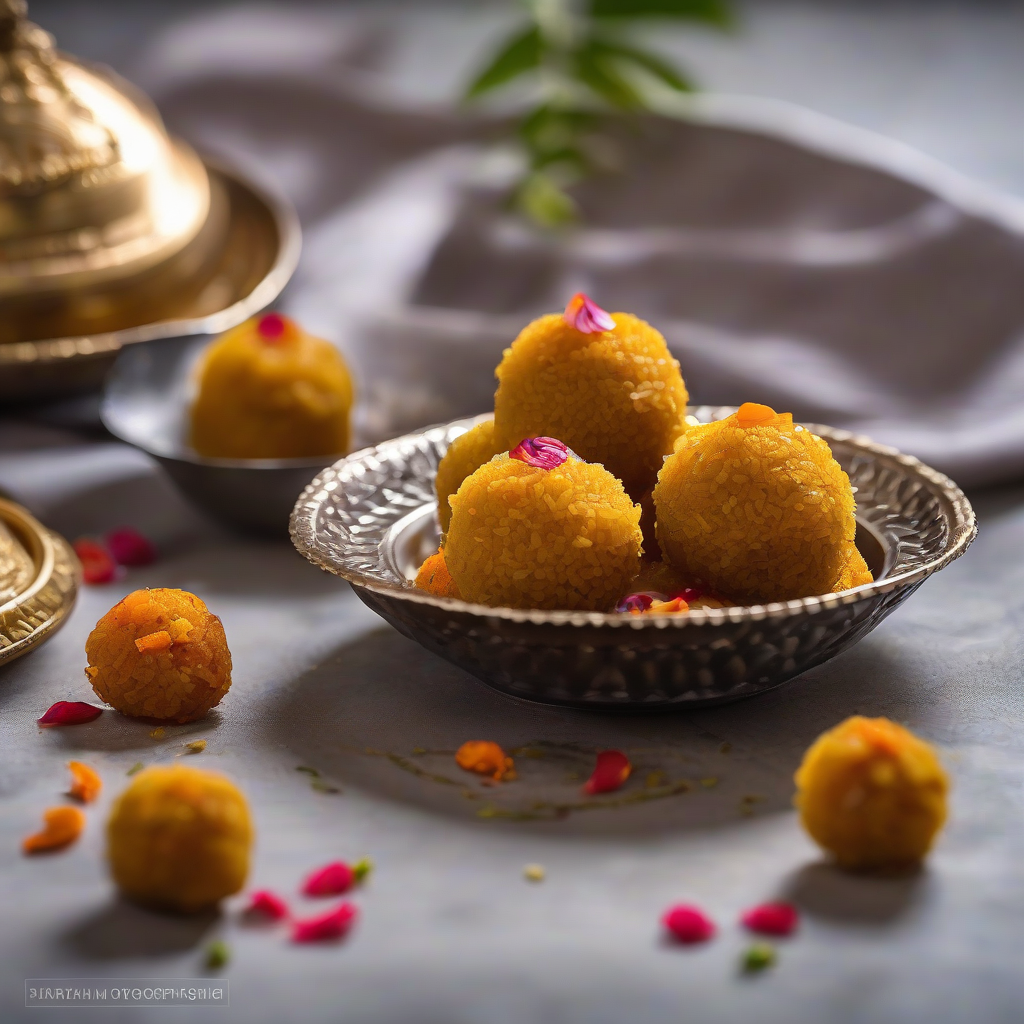Pahari Motichoor Laddu: Sweetness from the Hills, Made with Love!
Namaste Dosto! Kem cho? (Greetings friends! How are you?) Chef Curry Do’pyaza here, back in your kitchens and ready to add a sprinkle of magic to your day. Today, we are venturing into the cool, crisp air of the Himalayas with a sweet treat that’s as heartwarming as a cozy bonfire on a chilly night: Pahari Motichoor Laddu!
These gorgeous, golden orbs of deliciousness are more than just sweets; they are a symbol of celebration and togetherness. Up in the hills, especially in Himachal Pradesh and Uttarakhand, you’ll find these laddus gracing every auspicious occasion. Think weddings, festivals like Diwali and Dussehra, or even just a simple puja at home. They are a must-have! The sweet, nutty aroma fills the air, promising joy and good fortune.
A Little History Lesson
The story of Motichoor Laddu is as fascinating as its taste. While the exact origins are shrouded in a bit of mystery, it’s believed to have evolved from simpler forms of sweetmeats made with gram flour (besan). The “motichoor” part, meaning “crushed pearls,” refers to the tiny, delightful boondi (small fried balls) that make up the laddu. Over time, each region added its own unique touch, resulting in the delicious variations we enjoy today. Pahari Motichoor Laddu is particularly known for its slightly coarser texture and the use of locally sourced ingredients, giving it a distinct earthy flavor.
Get Ready to Cook!
Preparation Time: 20 minutes
Cooking Time: 45 minutes
What You’ll Need (Ingredients):
- Besan (Gram Flour): 2 cups – the heart and soul of our laddu.
- Ghee (Clarified Butter): 1 cup – for that rich, melt-in-your-mouth texture.
- Sugar: 1 ½ cups – for the perfect sweetness.
- Water: 1 cup + ½ cup – to create the batter and sugar syrup.
- Elaichi Powder (Cardamom Powder): ½ teaspoon – a fragrant touch of spice.
- Kesar (Saffron Strands): A pinch – for color and a hint of luxury (optional).
- Magaz (Melon Seeds): 2 tablespoons – for a delightful crunch (optional).
- Oil or Ghee for Frying: As needed – to fry the boondi.
- Yellow Food Color: A tiny pinch (optional) – to enhance the color.
Let’s Get Cooking (Instructions):
- Make the Batter: In a large bowl, whisk together the besan and 1 cup of water until you have a smooth, lump-free batter. The consistency should be like a thick pancake batter. Add the yellow food color, if using. Let it rest for 15 minutes.
- Prepare the Sugar Syrup: In a saucepan, combine the sugar and ½ cup of water. Heat over medium heat, stirring constantly until the sugar dissolves. Bring to a boil and simmer for about 5-7 minutes, or until the syrup reaches a slightly sticky consistency (one-string consistency). Add the cardamom powder and saffron strands (if using). Set aside.
- Fry the Boondi: Heat oil or ghee in a deep frying pan or kadhai over medium heat. To check if the oil is hot enough, drop a tiny bit of batter into the oil; it should rise to the surface immediately.
- Using a slotted spoon or a boondi jhara (a perforated ladle specifically for making boondi), pour the batter through the holes, allowing small droplets to fall into the hot oil. Fry until the boondi is lightly golden and crisp.
- Remove the boondi with a slotted spoon and drain on paper towels.
- Soak the Boondi: While the boondi is still warm, add it to the warm sugar syrup. Mix well to ensure the boondi is evenly coated. Let it soak for about 30 minutes, or until the boondi has absorbed most of the syrup.
- Shape the Laddus: Add the ghee and melon seeds to the boondi mixture. Mix well. Take a small portion of the mixture in your hand and gently press and shape it into a round laddu. Repeat with the remaining mixture.
- Let them Set: Place the laddus on a plate and let them set for a few hours, or until they are firm.
Chef’s Tips for Perfect Laddus
- Consistency is Key: The batter should be smooth and not too thick or too thin. Adjust the water accordingly.
- Oil Temperature: The oil should be hot enough to fry the boondi quickly, but not so hot that it burns.
- Sugar Syrup: The sugar syrup should be sticky, but not too thick. Overcooked syrup will result in hard laddus.
- Soaking Time: Don’t rush the soaking process. Give the boondi enough time to absorb the syrup for soft and juicy laddus.
- Ghee is Gold: Don’t skimp on the ghee! It adds richness and helps bind the laddus together.
Cooking Variations for the Modern Cook
- Gas Stove: The traditional method, perfect for achieving that authentic flavor.
- Induction Stove: Use medium heat settings for consistent results.
- Air Fryer: While not traditional, you can try air frying the boondi for a healthier option. Reduce the oil significantly.
- Microwave: Not recommended for this recipe.
Nutritional Information (Approximate per Laddu)
- Calories: 150-200
- Fat: 8-12g
- Carbohydrates: 18-25g
- Protein: 2-3g
(Note: These values are approximate and may vary depending on the specific ingredients and portion sizes.)
Serving Suggestions
Serve these luscious laddus at room temperature. They pair beautifully with a cup of hot chai or coffee. They also make a wonderful gift for friends and family!
A Sweet Call to Action
So, my dear friends, are you ready to bring the taste of the Himalayas to your home? Try this Pahari Motichoor Laddu recipe and experience the joy of creating something truly special. Share these delightful treats with your loved ones and spread the sweetness! Happy cooking!
